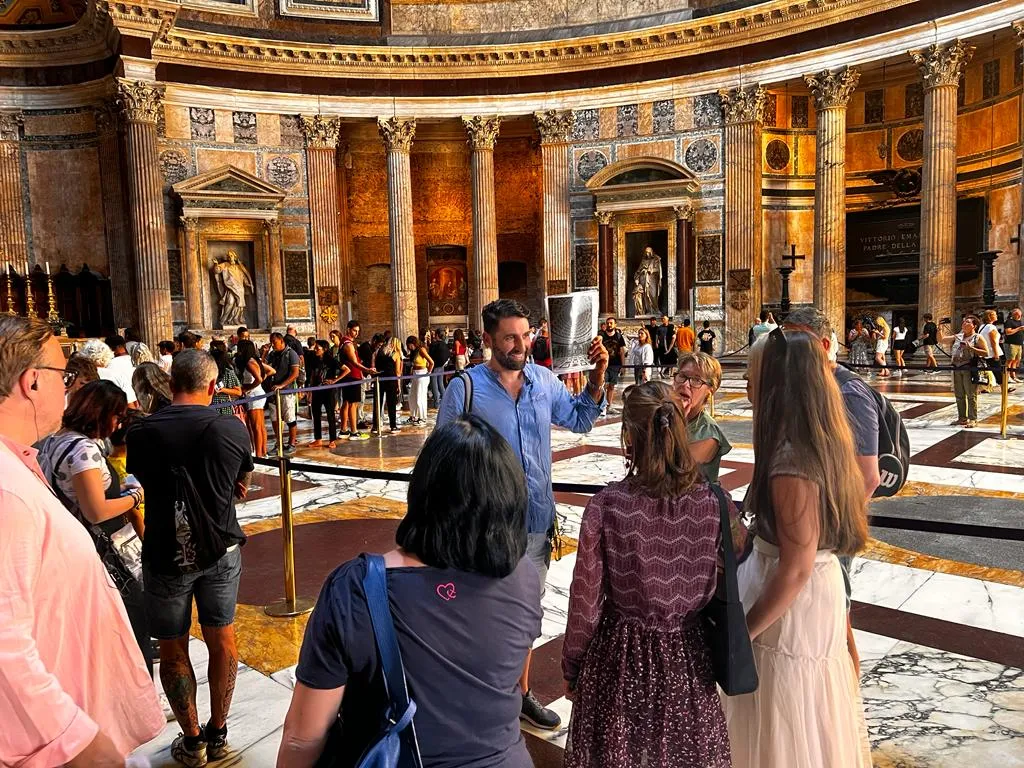The Pantheon is one of the most iconic and best-preserved monuments of Ancient Rome. Located in the heart of the Eternal City, it stands as a testament to the engineering brilliance and artistic sensibility of Roman civilization. Originally built as a temple to all gods, the structure has served various purposes throughout history, including as a Christian church.
If you’re planning a visit to Rome, one of the best ways to experience this historical gem is through Golf Cart Tours, which provide a comfortable and immersive way to explore the city’s highlights.

Foundations built for Eternity
The Pantheon was constructed on marshy land, requiring robust foundations to support its enormous weight. These foundations are trench-based, 7 meters thick and 4.5 meters deep, with a diameter of 40.3 meters. A reinforcing ring was integrated into the structure to provide additional support. Combined with the front portico and other architectural elements, this reinforcement helps maintain the Pantheon’s structural integrity to this day.
This smart build ensured the house could withstand many years of nature’s tests. Even with the hard land, Roman builders made a base so strong that it still stands today. It moves young builders all over the world.
The Pronaos: A grand entrance
Inspired by Greek architecture, the Pantheon’s pronaos features 16 Corinthian columns and spans 34.2 by 15.62 meters. Elevated a meter above the square in ancient times, it was accessible by a series of steps. The front eight columns are crafted from gray granite sourced in Egypt, while the capitals and bases are made from white Pentelic marble. The pediment once displayed a bronze high relief, possibly depicting a mythological battle.
This huge door marked a significant shift from the bustling Roman Forum to the holy circular hall. The size and even look of the front porch show off the grand style of the empire and nod to old Greek temples.
The Vestibule and ancient door
Connecting the pronaos to the main rotunda is the vestibule, or “avancorpo.” Built with brick and adorned with Pentelic marble, this area houses stairways inside two large pillars, which allowed access to the upper levels. Between the pilasters are ornate marble panels with motifs like garland, sacrificial tools, and religious symbols. The bronze doors—measuring over 7 meters high—are considered the oldest in Rome still in use today.
This in-between space not only had a key role in holding up the building, but also made the walk into the big round room more special. The great work in the small hall shows the care in the building’s design and how important the place is in a deep, heartfelt way.
The Rotunda: A cylindrical wonder
At the heart of the Pantheon lies the rotunda, a cylindrical chamber built using various materials and innovative techniques. The lower walls contain concrete mixed with travertine and tuff, while higher sections use lighter materials like brick and pumice. The construction relied on opus caementicium and opus latericium methods—concrete poured between brick facing walls. Massive piers and relieving arches bear the weight of the colossal dome above.
This smart building plan spreads weight in a way that lets the round space stay in great shape. It’s just the right size, and smooth lines form a stunning area. It shows how good Roman builders were. Their work still shapes how we build things all over the world today.
The Dome: A feat of Roman Engineering
The Pantheon’s dome remains the largest unreinforced concrete dome in the world. Measuring 43.44 meters in diameter, it was constructed with progressively lighter materials toward the oculus to reduce pressure. From heavy bricks at the base to hollow terracotta pots near the top, this gradation in weight was essential. The ceiling features five rows of coffers, not only reducing weight but also adding decorative elegance.
The Oculus, a big round hole at the top of the dome, lets in sunlight and makes a link to the sky. This cool design shows how smart the Romans were with building and their chase for space and peace in the soul.
The Oculus: Light from the Heavens
The nine-meter-wide oculus at the dome’s apex is the building’s sole light source and a symbol of divine presence. This open-air window bathes the interior in natural light and aligns with solar events, such as the emperor’s birthday or equinox. When it rains, the floor’s subtle slope and drainage holes remove excess water. The oculus transforms the Pantheon from mere structure to spiritual experience.
Why the Pantheon still captivates today
A visit to the Pantheon is a journey into the architectural genius and spiritual depth of ancient Rome. With its unmatched preservation and continued use, it remains a powerful symbol of Rome’s enduring legacy. Whether you’re a history buff, an architecture enthusiast, or simply a curious traveler, the Pantheon offers an experience that is both humbling and awe-inspiring. No wonder it is one of the top things to do in Rome during your upcoming vacation.


